One of the most representative foods of the Seollal Lunar New Year's, one of Korea’s biggest holidays, is tteokguk rice cake soup.
Another menu item that’s eaten during the holiday are jeon savory pancakes. Although jeon refers to any ingredient coated with batter and pan-fried in thin pies, it can come in many shapes and many flavors, depending on where it’s made and of what it’s made. As Seollal is coming up this week, the Rural Development Administration on Jan. 24 published seven great recipes for special types of jeon that have been passed down in various regions across Korea.
○ Yangpyeongmajeon (양평마전) from Gyeonggi-do Province
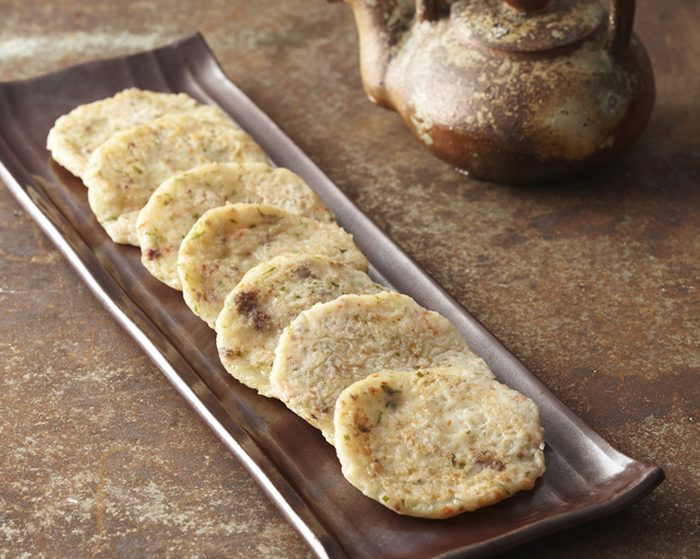
Yangpyeongmajeon is a traditional food from Gyeonggi-do Province made of the roots of the cinnamon vine (마). Ground beef is added to the batter that's made with the root. The root contains plenty of enzymes to help you digest your heavy holiday meal.
** Ingredients
200 grams cinnamon vine root
100 grams ground beef
110 grams all-purpose flour
200 grams onion
50 grams carrot
70 grams green onion
15 milliliters oil
-- Beef seasoning
15 milliliters soy sauce
4 grams sugar
4.5 grams finely-chopped green onion
5 grams crushed garlic
4 grams sesame oil
2 grams crushed sesame seed
1 gram ground pepper
** Cooking
1. Peel off the tough skin of the cinnamon vine root and grind it up.
2. Mix the ground beef with the seasoning.
3. Finely chop the onion, carrot and green onion.
4. Mix all of the above with flour.
5. Preheat a frying pan with oil and put in a spoonful of batter. When the bottom gets golden and crispy, flip it over and cook the other side.
○ Gamjabuchim (감자부침) from Gangwon-do Province
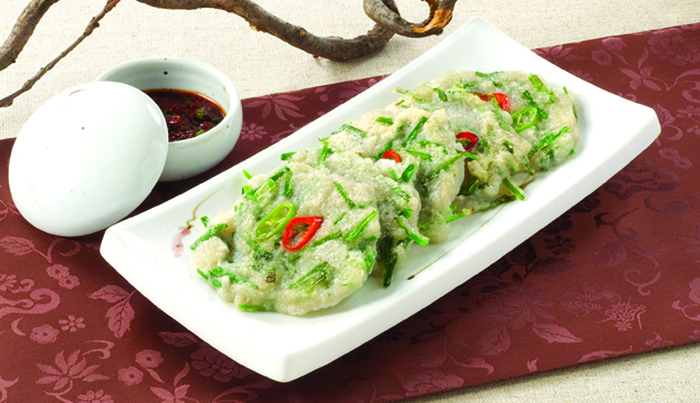
Potatoes are one of the representative foods of Gangwon-do Province. Gamjabuchim, or potato savory pancake from Gangwon-do, is made from grated potatoes with chives and small spring onions.
** Ingredients
1 kilogram potatoes
50 grams chives
20 grams small spring onion
60 grams red pepper
60 grams green pepper
2 grams salt
15 milliliters oil
** Cooking
1. Wash and peel the potatoes and grate them.
2. Leave the grated potatoes in a bowl until the moisture from the potatoes becomes clear. Drain the water.
3. Cut the chives and small green onions into 2-centimeter lengths.
4. Cut the red and green peppers into diagonal slices 0.3 centimeters long. Rinse the pepper slices in water to shake off the seeds.
5. Add the chives, green onions and salt to the grated potatoes.
6. Pre-heat a pan with oil and add a drop of batter with a ladle. Put the red and green pepper slices on top for decoration.
7. When the bottom is fully cooked, flip it over and cook the other side.
○ Chikjeon (칡전) from Chungcheongbuk-do Province
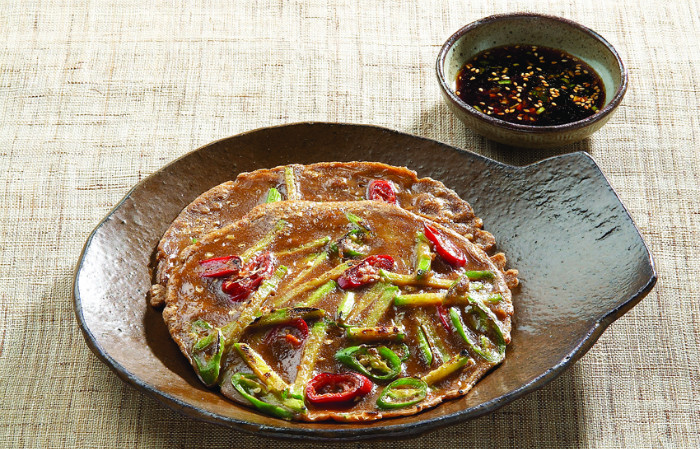
In Chungcheongbuk-do Province, people enjoy chikjeon or kudzu root savory pancake.
This savory pancake is made from kudzu root starch, flour and water. The batter is passed through a strainer for a softer texture. Vegetables are added and then it's pan-fried. Chikjeon gets chewier with the addition of more glutinous rice flour. It tastes similar to potato pancakes.
** Ingredients
160 grams kudzu root starch
55 grams all-purpose flour
15 grams green peppers
15 grams red peppers
80 grams zucchini
400 milliliters water
2 grams salt
15 milliliters oil
** Cooking
1. Mix the kudzu root starch, flour and water and let it pass through a strainer to make the batter a bit softer.
2. Chop the zucchini into strips (5 cm by 0.3 cm by 0.3 cm) and slice the red and green peppers into 0.3 centimeter lengths. Add the vegetables to the batter.
3. Pre-heat a pan with oil and add a thin layer of batter. Flip occasionally to cook fully.
○ Baechujeon (배추전) from Gyeongsangbuk-do Province
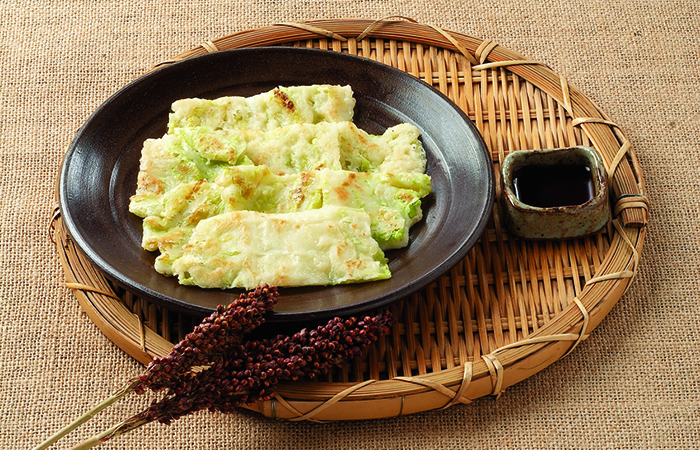
Baechujeon or nappa cabbage savory pancakes are made by beating a cabbage leaf for tenderness. The leaf is then seasoned with salt and made into a pancake. They're a delightful way to enjoy the sweetness of the vegetable.
** Ingredients
6 nappa cabbage leaves
80 grams flour
80 grams water
4 grams salt
4 grams sesame oil
15 milliliters oil
** Cooking
1. Gently beat the cabbage leaf with the back of a knife and season it with salt. Be careful not to break the leaf.
2. Mix the flour with the water, sesame oil and salt.
3. Sprinkle some flour on the leaf and coat it with batter.
4. Pre-heat a pan with oil and cook both sides of the leaf.
5. Cut the baechujeon before serving and enjoy with soy sauce mixed with vinegar.
○ Chopijangtteok (초피장떡) from Gyeongsangnam-do Province
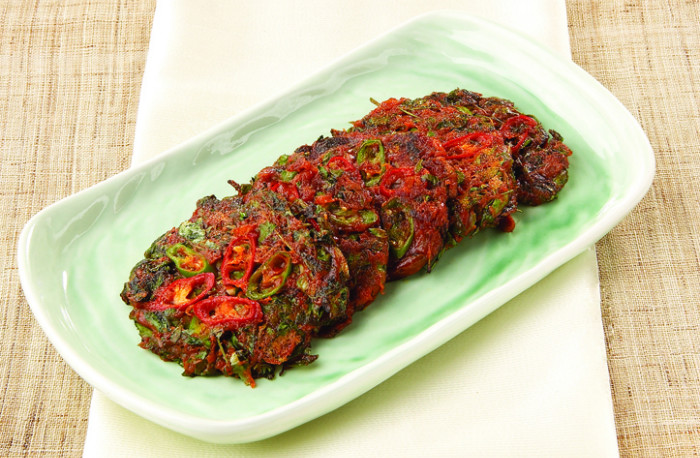
Chopi is a type of spice that creates a burning and tingling sensation.
Old Korean cookbooks, such as the “Eumsik Dimibang” (음식디미방, 飮食知味方), “Jubangmun” (주방문, 酒方文) and "Sanrimgyeongje" (산림경제, 山林經濟), say that chopi was used to make kimchi before red peppers were first imported into Korea during Joseon times.
Young and tender chopi leaves are used to make chopijangtteok. The batter for the pancake is made with doenjang soybean paste (된장), gochujang red pepper paste (고추장), water and flour. Chopi leaves, red peppers and green peppers are then added to it.
** Ingredients
50 grams chopi leaves
1 tablespoon deonjang
3 tablespoons gochujang
110 grams all-purpose flour
14 grams green peppers
16 grams red peppers
15 milliliters oil
100 milliliters water
** Cooking
1. Chop the chopi leaves into 1-centimeter slices.
2. Slice the green and red peppers into strips that are 0.3 centimeters thin.
3. Mix the soybean paste, red pepper paste, water and four and add in the chopped vegetables.
4. Pre-heat a pan with oil and pan-fry a spoonful of batter. Cook both sides.
○ Dasimajeon (다시마전) from Jeollabuk-do Province
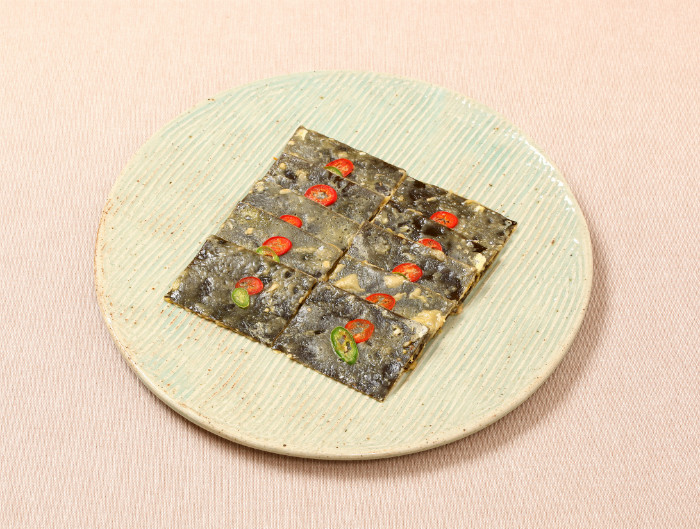
Dasima (다시마), a type of seaweed, is usually dried and used to make broth. In Jeollabuk-do Province, however, people season dasima and coat it with flour and eggs to make a jeon savory pancake.
** Ingredients
20 grams dried dasima
50 grams all-purpose flour
100 grams eggs
15 milliliters oil
-- Seasoning
15 milliliters soy sauce
4.5 grams finely-chopped green onion
5 grams crushed garlic
2 grams crushed sesame seeds
** Cooking
1. Rinse the dasima with clean water and soak it in water. When softened, cut it into small pieces (2 cm by 3 cm).
2. Mix the seasoning ingredients together and leave the dasima pieces in it for 5 minutes.
3. Coat the seasoned dasima with flour and beaten egg. Pan fry both sides of the dasima in a pre-heated pan with oil.
○ Guljeon (굴전) from Jeollanam-do Province
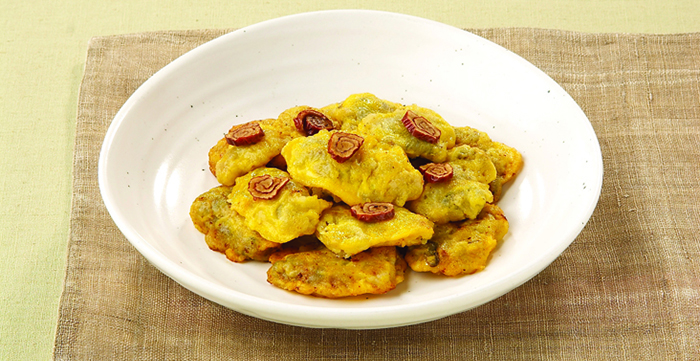
Jeollanam-do is home to most of the oysters consumed in Korea.
Guljeon, a type of savory oyster pancake, is one of the best ways to enjoy the fresh flavor of Jeollanam-do's delicious seafood.
** Ingredients
300 grams oysters
100 grams egg
55 grams all-purpose flour
2 grams salt
15 milliliters oil
** Cooking
1. Rinse the oysters with clean water two or three times and drain away any excess water.
2. Beat the eggs and add salt.
3. Group smaller oysters into groups and coat them with flour and then with beaten egg.
4. Pre-heat a pan with oil and cook the coated oysters.
By Kim Young Shin
Korea.net Staff Writer
Photos: Rural Development Administration
ysk1111@korea.kr
Another menu item that’s eaten during the holiday are jeon savory pancakes. Although jeon refers to any ingredient coated with batter and pan-fried in thin pies, it can come in many shapes and many flavors, depending on where it’s made and of what it’s made. As Seollal is coming up this week, the Rural Development Administration on Jan. 24 published seven great recipes for special types of jeon that have been passed down in various regions across Korea.
○ Yangpyeongmajeon (양평마전) from Gyeonggi-do Province

Yangpyeongmajeon is a traditional food from Gyeonggi-do Province made of the roots of the cinnamon vine (마). Ground beef is added to the batter that's made with the root. The root contains plenty of enzymes to help you digest your heavy holiday meal.
** Ingredients
200 grams cinnamon vine root
100 grams ground beef
110 grams all-purpose flour
200 grams onion
50 grams carrot
70 grams green onion
15 milliliters oil
-- Beef seasoning
15 milliliters soy sauce
4 grams sugar
4.5 grams finely-chopped green onion
5 grams crushed garlic
4 grams sesame oil
2 grams crushed sesame seed
1 gram ground pepper
** Cooking
1. Peel off the tough skin of the cinnamon vine root and grind it up.
2. Mix the ground beef with the seasoning.
3. Finely chop the onion, carrot and green onion.
4. Mix all of the above with flour.
5. Preheat a frying pan with oil and put in a spoonful of batter. When the bottom gets golden and crispy, flip it over and cook the other side.
○ Gamjabuchim (감자부침) from Gangwon-do Province

Potatoes are one of the representative foods of Gangwon-do Province. Gamjabuchim, or potato savory pancake from Gangwon-do, is made from grated potatoes with chives and small spring onions.
** Ingredients
1 kilogram potatoes
50 grams chives
20 grams small spring onion
60 grams red pepper
60 grams green pepper
2 grams salt
15 milliliters oil
** Cooking
1. Wash and peel the potatoes and grate them.
2. Leave the grated potatoes in a bowl until the moisture from the potatoes becomes clear. Drain the water.
3. Cut the chives and small green onions into 2-centimeter lengths.
4. Cut the red and green peppers into diagonal slices 0.3 centimeters long. Rinse the pepper slices in water to shake off the seeds.
5. Add the chives, green onions and salt to the grated potatoes.
6. Pre-heat a pan with oil and add a drop of batter with a ladle. Put the red and green pepper slices on top for decoration.
7. When the bottom is fully cooked, flip it over and cook the other side.
○ Chikjeon (칡전) from Chungcheongbuk-do Province

In Chungcheongbuk-do Province, people enjoy chikjeon or kudzu root savory pancake.
This savory pancake is made from kudzu root starch, flour and water. The batter is passed through a strainer for a softer texture. Vegetables are added and then it's pan-fried. Chikjeon gets chewier with the addition of more glutinous rice flour. It tastes similar to potato pancakes.
** Ingredients
160 grams kudzu root starch
55 grams all-purpose flour
15 grams green peppers
15 grams red peppers
80 grams zucchini
400 milliliters water
2 grams salt
15 milliliters oil
** Cooking
1. Mix the kudzu root starch, flour and water and let it pass through a strainer to make the batter a bit softer.
2. Chop the zucchini into strips (5 cm by 0.3 cm by 0.3 cm) and slice the red and green peppers into 0.3 centimeter lengths. Add the vegetables to the batter.
3. Pre-heat a pan with oil and add a thin layer of batter. Flip occasionally to cook fully.
○ Baechujeon (배추전) from Gyeongsangbuk-do Province

Baechujeon or nappa cabbage savory pancakes are made by beating a cabbage leaf for tenderness. The leaf is then seasoned with salt and made into a pancake. They're a delightful way to enjoy the sweetness of the vegetable.
** Ingredients
6 nappa cabbage leaves
80 grams flour
80 grams water
4 grams salt
4 grams sesame oil
15 milliliters oil
** Cooking
1. Gently beat the cabbage leaf with the back of a knife and season it with salt. Be careful not to break the leaf.
2. Mix the flour with the water, sesame oil and salt.
3. Sprinkle some flour on the leaf and coat it with batter.
4. Pre-heat a pan with oil and cook both sides of the leaf.
5. Cut the baechujeon before serving and enjoy with soy sauce mixed with vinegar.
○ Chopijangtteok (초피장떡) from Gyeongsangnam-do Province

Chopi is a type of spice that creates a burning and tingling sensation.
Old Korean cookbooks, such as the “Eumsik Dimibang” (음식디미방, 飮食知味方), “Jubangmun” (주방문, 酒方文) and "Sanrimgyeongje" (산림경제, 山林經濟), say that chopi was used to make kimchi before red peppers were first imported into Korea during Joseon times.
Young and tender chopi leaves are used to make chopijangtteok. The batter for the pancake is made with doenjang soybean paste (된장), gochujang red pepper paste (고추장), water and flour. Chopi leaves, red peppers and green peppers are then added to it.
** Ingredients
50 grams chopi leaves
1 tablespoon deonjang
3 tablespoons gochujang
110 grams all-purpose flour
14 grams green peppers
16 grams red peppers
15 milliliters oil
100 milliliters water
** Cooking
1. Chop the chopi leaves into 1-centimeter slices.
2. Slice the green and red peppers into strips that are 0.3 centimeters thin.
3. Mix the soybean paste, red pepper paste, water and four and add in the chopped vegetables.
4. Pre-heat a pan with oil and pan-fry a spoonful of batter. Cook both sides.
○ Dasimajeon (다시마전) from Jeollabuk-do Province

Dasima (다시마), a type of seaweed, is usually dried and used to make broth. In Jeollabuk-do Province, however, people season dasima and coat it with flour and eggs to make a jeon savory pancake.
** Ingredients
20 grams dried dasima
50 grams all-purpose flour
100 grams eggs
15 milliliters oil
-- Seasoning
15 milliliters soy sauce
4.5 grams finely-chopped green onion
5 grams crushed garlic
2 grams crushed sesame seeds
** Cooking
1. Rinse the dasima with clean water and soak it in water. When softened, cut it into small pieces (2 cm by 3 cm).
2. Mix the seasoning ingredients together and leave the dasima pieces in it for 5 minutes.
3. Coat the seasoned dasima with flour and beaten egg. Pan fry both sides of the dasima in a pre-heated pan with oil.
○ Guljeon (굴전) from Jeollanam-do Province

Jeollanam-do is home to most of the oysters consumed in Korea.
Guljeon, a type of savory oyster pancake, is one of the best ways to enjoy the fresh flavor of Jeollanam-do's delicious seafood.
** Ingredients
300 grams oysters
100 grams egg
55 grams all-purpose flour
2 grams salt
15 milliliters oil
** Cooking
1. Rinse the oysters with clean water two or three times and drain away any excess water.
2. Beat the eggs and add salt.
3. Group smaller oysters into groups and coat them with flour and then with beaten egg.
4. Pre-heat a pan with oil and cook the coated oysters.
By Kim Young Shin
Korea.net Staff Writer
Photos: Rural Development Administration
ysk1111@korea.kr